
Hanging succulent plants provide drama and beauty to your home or garden, and since they’re low-maintenance, they’re easy to look after, even if you’re a beginner gardener. But which ones are the most beautiful to choose?
Some of the best-hanging succulent plants that hang or trail include Christmas Cactus, String of Hearts, Calico Kitten, and Elephant Bush. These fall over suspended baskets and add greenery to your home.
I’ll explore these plants and other types of hanging succulents in this article. I’ll break down what to know about them and feature tips on caring for them so that they look their best.
1. Schlumbergera bridgesii “Christmas Cactus”

This flowering succulent blooms tube-shaped flowers in neon pink or soft lilac, so it’s an eye-catching addition to your home. Although it’s a succulent, it’s native to tropical rainforests in Brazil, where it thrives in high levels of humidity and dappled sunlight.
It has long stems that grow over the rim of its pot or container. To ensure that it continues to grow branches and increase its flower yield, prune your Christmas Cacti. To do this, cut a few sections off on each stem. The plant will produce new branches from these wounds.
To care for your Christmas Cactus, make sure you follow these important tips:
- Keep the plant in an area of the home where it will be exposed to bright, indirect light; an example is an east-facing window.
- Avoid giving the plant too much direct sunlight, as this can bleach its leaves.
- Water the plant every three weeks, and check that the top one-third of the soil feels dry, as this indicates it needs water.
2. Ceropegia woodii ‘String of Hearts’

This trailing succulent that hails from South Africa gets its name because it has dark green, heart-shaped leaves with silver variegations. Its stems can reach lengths between three and nine feet (0.9-2.7 m), so you want to place it in a vertical space to make the most of its trailing effect.
To care for your String of Hearts plant, follow these important tips.
- Give String of Hearts bright, indirect light. This plant won’t survive in areas of low light. Similarly, too much bright light will burn its leaves. When you place it in bright, indirect light, its leaves’ variegation will be enhanced, as MasterClass reports.
- Water your String of Hearts once or twice a week. Its soil should dry out before you water it again. The plant has water-storing leaves, so it is tolerant of dry conditions.
- Avoid cold conditions. A String of Hearts is a succulent that doesn’t fare well in cold conditions, so ensure you never expose it to temperatures lower than 40°F (4.4°C).
3. Crassula pellucida variegata ‘Calico Kitten’
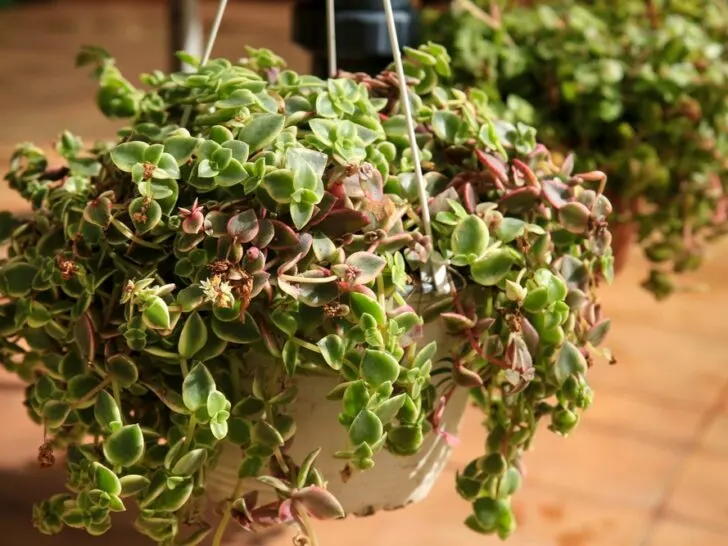
This colorful succulent drapes over hanging containers, but you can also use it as a beautiful ground cover. When the plant grows, its stems start to form arches and can reach up to 12 inches (30.48 cm) in length. Its leaves are rosy-pink, green, or white, which add color to your home.
Here’s how to care for your Calico Kitten plant:
- Let its soil dry out between waterings. You should water your succulents thoroughly but infrequently. If you leave the plant to become waterlogged, it will be at risk of root rot.
- Give it bright indoor light. This succulent should be placed in an east- or west-facing window when kept indoors. It wants a lot of sun.
- Plant it in well-draining soil. As with other succulents, you should ensure that you give your Calico Kitten well-draining soil.
4. Dischidia nummularia ‘String of Nickels’
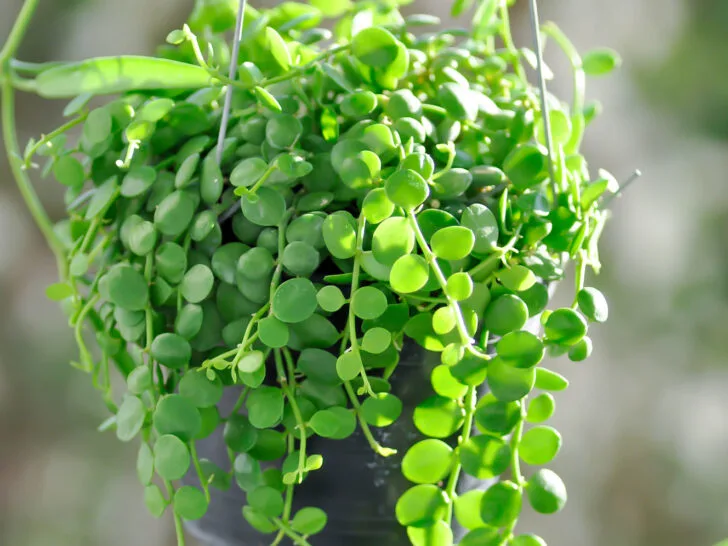
The String of Nickels originates from tropical regions of the world, such as India and Australia. In the wild, it grows on other plants and gets the moisture it needs from the rain or air. As its name suggests, its leaves look like nickels, although they’re bright green in color.
This succulent grows quickly, so it’s ideal for placing in an area of the home that requires greenery. It reaches a height of between 12 and 18 inches (30.48-45.72 cm) and spreads to between 15 and 24 inches (38.1-61 cm), as The Spruce reports.
To ensure that your String of Nickels will grow and vine, give it lots of space for its roots. You should repot it every year. Here are other tips you should follow when looking after this pretty succulent.
- The String of Nickels requires low-light conditions, so it can be kept in east- or north-facing windows. Ensure that the room gets a bit of sunlight, though.
- Keep it in a light, well-draining medium. An orchid potting mix is effective. I’d recommend Miracle-Grow Orchid Potting Mix (available from Amazon.com). It feeds your plants for up to six months and is a fast-draining product.
5. Dischidia ovata watermelon

This “Watermelon” trailing plant should be placed high in the home in a pot or hanging basket so that it can trail all the way down, adding a touch of tropical flair to your home. It has egg-shaped leaves with white markings on them that resemble tiny watermelons!
- Keep your Watermelon succulent in a spot where it will receive bright, indirect light. Its leaves will become bright red when exposed to too much light, so if this happens, it is a sign that it’s receiving too much light.
- Water your plant when the surface of its soil feels dry so that it doesn’t sit in too much water, as this can cause root rot.
- Plant it in a light potting mix. This will prevent it from sitting in a soggy medium. Ideally, the mix should contain bark. I’d recommend rePotme Succulent Soil Potting Mix (available on Amazon.com). It contains ingredients that enhance drainage, such as medium pumice rock and Monterey pine bark.
6. Portulacaria afra ‘Elephant Bush’
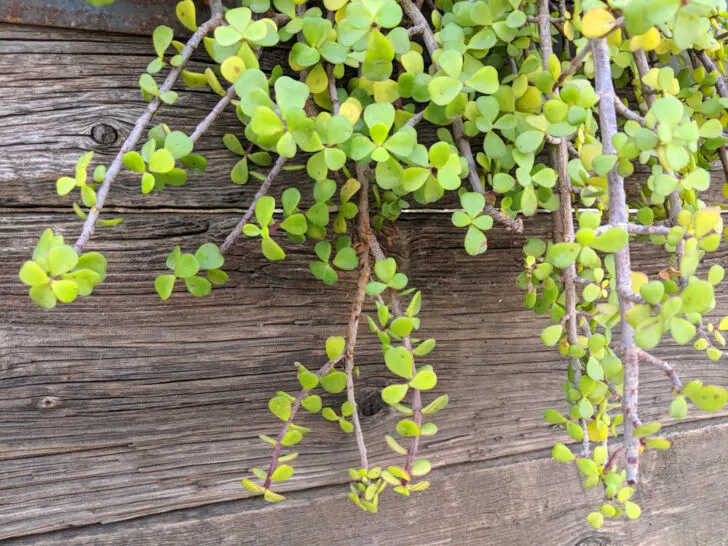
Elephant Bush, which originates from South Africa, is a perennial succulent shrub that displays beautiful woody stems and fleshy green leaves, both of which make it beautiful when used as a spiller plant for large containers. This plant can reach up to 12 feet (3.7 m) in height!
When given ideal growing conditions, Elephant Bush will display clustered flowers that are purple, white, or pink. To give your succulent the best care, make sure you follow these tips:
- Plant it in an area that gets either full sun or partial shade. Inside the home, partial shade with some bright light is best.
- Allow the plant’s soil to dry before watering it. When planted outside, Elephant Bush wants more water during the summer months when it’s dry and hot.
- Plant it in a well-draining potting mix. To avoid overwatering your plant, give it a well-draining potting mix that’s formulated for succulents or cacti. You should also add perlite to the mixture to enhance drainage.
7. Senecio radicans ‘Senecio Fish Hook’
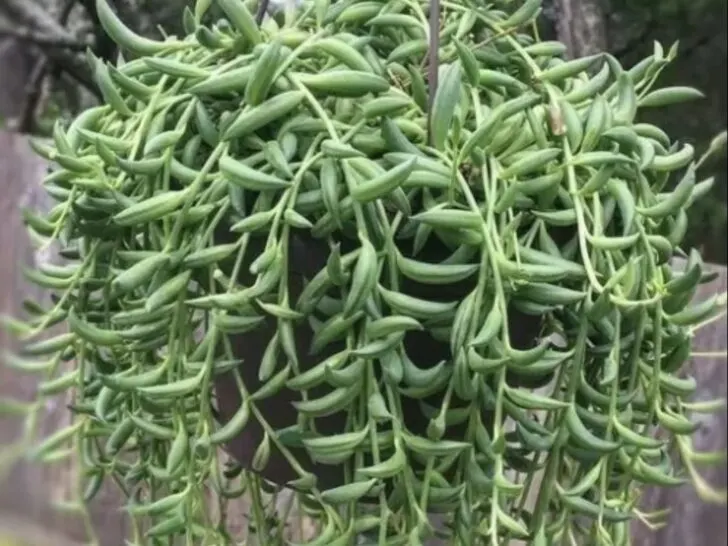
This unusual succulent that originates from South West Africa gets its name because its leaves look like small fish hooks. These trail over the plant’s container or pot, providing whimsy to any garden. Senecio Fish Hook grows quickly and reaches a maximum height of up to 33 feet (10 m).
To ensure that it maintains its beautiful trailing nature, make sure you follow these tips:
- Give it bright, indirect light. Never let it sit in the strong midday sun, so be careful about where you plant it.
- When kept indoors, this plant performs best when temperatures are kept between 64-75°F (18-24°C).
- Although you should let its soil dry out between waterings, this succulent wants humidity. Keep it in an area that gets a lot of humidity, such as the bathroom or kitchen.
8. Hoya carnosa ‘The Hindu Rope/Wax Plant’

The Hindu Rope plant is a curlier version of the wax plant Hoya Carnosa. It’s a semi-succulent plant that boasts waxy green leaves and curling vines. It even blooms! Native to Australia and East Asia, the Hindu Rope plant grows slowly but puts stunning flowers on display during the spring and summer. These are star-shaped and pink or white in color.
Hindu Rope plants trail beautifully over shelves or containers, and they reach a maximum length of up to 15 inches (38 cm), so they’re ideal for small spaces. Tips to follow when caring for your Hindu Rope plant include the following:
- Plant it in an area that gets bright, indirect light. Too much sun can burn its leaves.
- Plant it in a fast-draining potting mix, as it doesn’t perform well in heavy, soggy soil, as The Spruce reports.
- Water it when the first few inches (approx. 5-7 cm) of soil are completely dry.
- This plant wants warm temperatures, so make sure the temperature is consistently above 50°F (10°C).
9. Dorotheanthus bellidiformis ‘Ice Plant’

Sometimes called the Daisy Plant because its flowers resemble daisies, the Ice Plant is easy to care for, so it’s great for gardening beginners. It can be planted in any sunny location and will thrive. It’s also highly resistant to drought.
It has beautiful foliage that trails, so make it drape over a wall or use it as ground cover for a garden bed. You want to put it in an area of the garden where you’ll be able to enjoy its beautiful red flowers. It reaches a height of up to 0.75 feet (0.2 m) and a spread of up to two feet (0.6 m).
Caring for this low-maintenance plant includes:
- Not overwatering it. But don’t let its soil dry out completely between waterings either, as the Missouri Botanical Garden reports.
- Planting it in dry, gravelly, or sandy soil.
- Ensuring good soil drainage.
10. Othonna capensis ‘Little Pickles, Ruby Necklace’
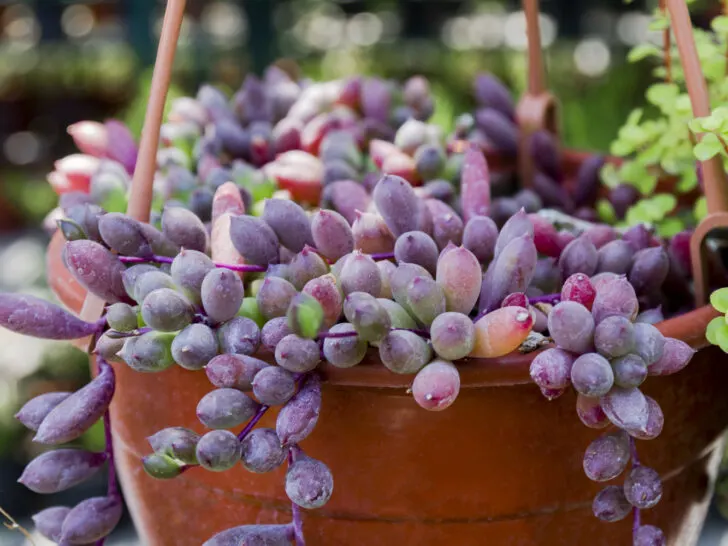
This succulent displays small green leaves that stand upright and look like tiny pickles. Although typically green, the leaves can sometimes turn a purple-red color, which makes it look even more beautiful when it cascades over a pot. This succulent, which originates in South Africa, can grow up to 12 inches (30.48 cm) in height and 24 inches (60.96 cm) in width.
Look after your succulent in the following ways:
- Store it in an area of the home or garden where it will get full to partial sun conditions. But you should give it as much light as possible because its green leaves will become red or purple when given more light.
- Water the plant thoroughly and let excess water seep out of the container’s drainage holes. You should only give it more water when the soil is completely dry.
- Keep its temperature at around 50°F (10°C) as it doesn’t like temperatures lower than that.
11. Sedum morganianum ‘Burro’s Tail’
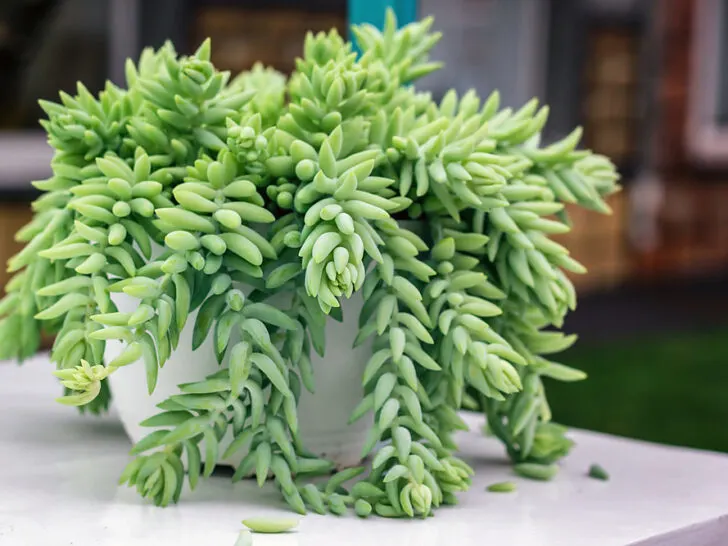
This plant gets its name because it grows in a long tube-like fashion, with clusters of fleshy green leaves. The plant’s stems can grow between two and four inches (5.08-10.16 cm) in length. Here’s how to care for this plant that’s native to southern Mexico:
- Soak its soil thoroughly when watering it. Unlike other succulents, Burro’s Tail wants a lot of water so that its leaves remain plump. But don’t water it again until the surface of the soil feels dry.
- Bring it indoors in winter. If your region has icy winters, bring your Burro’s Tail indoors during the cold season. It wants temperatures above 50°F (10°C). When the plant is kept indoors, moderate room temperature is sufficient during the summer.
- Give it at least four hours of sun daily. Adequate sunlight will ensure the plant thrives.
- Plant it in well-draining soil. You can make some yourself by mixing together equal parts of pumice or perlite and potting soil.
12. Sedum morganianum ‘Donkey Tail’
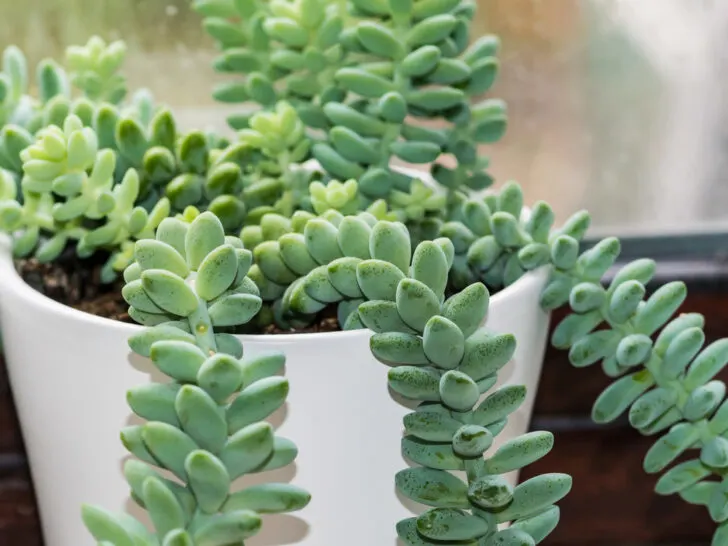
Although you might assume that “Donkey Tail” is the same plant as “Burro’s Tail,” there are some important differences between them. While the “Burro’s Tail” variety has oval-shaped leaves, the “Donkey Tail” variety has C-shaped leaves. The “Donkey Tail” plant’s leaves are also less compacted than what you’ll find on “Burro’s Tail.”
A “Donkey Tail” plant’s stems can grow up to 3.3 feet (1 m) in height! To ensure it grows to its full height and becomes a statement plant, care for it in the following ways.
- Provide it with bright sunlight. This plant needs at least six hours of bright light every day.
- Don’t give it too much water. Watering your Donkey Tail once or twice a month is enough. Test the soil with your fingers to see that it’s dry before giving it more water.
- Plant your Donkey Tail in a well-draining soil mix. This prevents the soil from becoming too waterlogged.
13. Senecio herreianus ‘String of Beads’
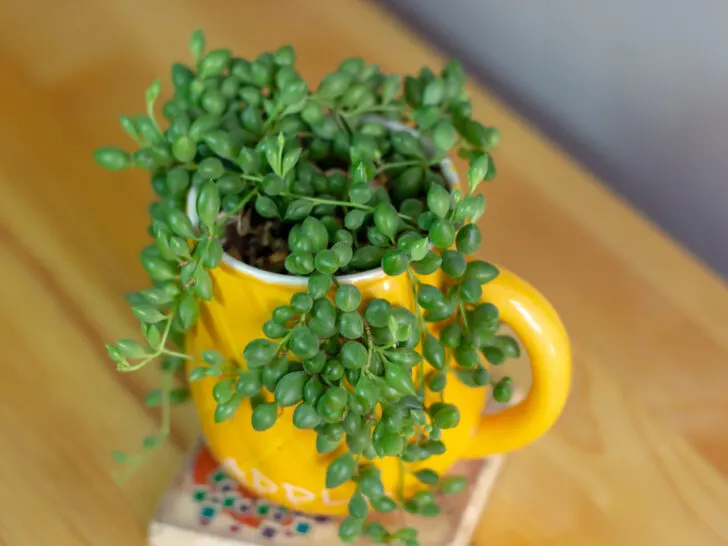
This succulent has a similar appearance to the String of Nickels we featured earlier in the article, but it overflows in fleshy round leaves that look like grapes. It has a compact appearance and looks great when its trailing stems are left to grow to the ground—it can trail up to three feet (0.9 m)! Make sure you keep it in bright light so that its leaves take on a red or purple hue.
Other tips for caring for your String of Beads plant include the following:
- Keep your plant moist in the spring through fall during the growing season. Water it enough to prevent the soil from drying out completely during the winter.
- Plant it in a well-draining potting medium. A cactus potting mix is effective.
- Give it average humidity, such as approximately 40%. However, if your indoor air is a bit dry, this won’t be a problem.
14. Senecio radicans ‘String of Bananas’

This succulent is praised for being a fast grower and low-maintenance, as The Spruce reports. It originates from South Africa and grows glossy leaves that are shaped like bananas, hence its name.
You can use it to fill up vertical space in your home because it looks great when hanging out of baskets, or you can even train it to grow along fences. It reaches a height of up to 36 inches (91.44 cm) when mature.
- Give your String of Bananas six hours of light. It needs to be direct light, or its leaves will be spaced out along the stem.
- Plant it in a well-draining soil mix. A premixed succulent soil mix will be fine.
- Keep it away from draughts and extreme temperatures. This means you should keep it away from air conditioners and heaters in the home.
15. Senecio rowleyanus ‘String of Pearls’
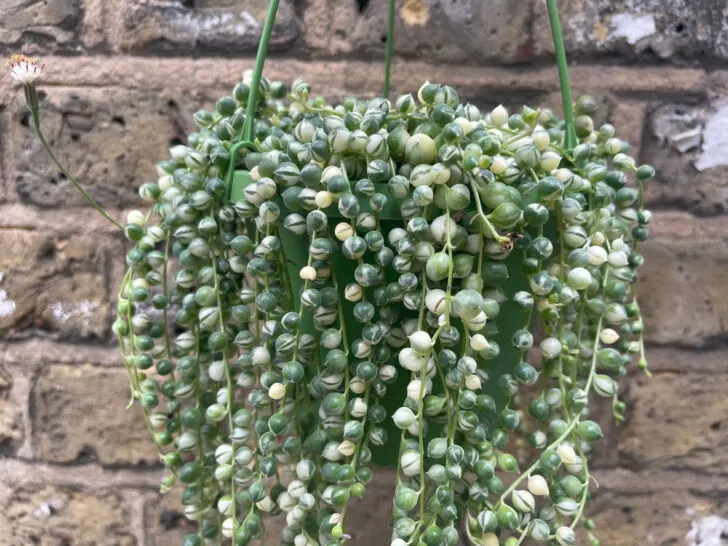
This succulent is similar to the String of Bananas, but its “pearls” look like peas all along the stems. It can trail up to about 3.3 feet (1 m) in length. Since its “pearls” store water, this plant doesn’t need to be watered regularly, so it won’t struggle to survive if you forget about it for a while.
- Treat it gently. The “pearls” of this plant can easily be damaged, so be careful. Place it in an area of the home where you won’t accidentally bump into it when walking past.
- Keep it in bright, indirect light.
- Water it from below. Put a dish filled with water underneath the plant so that it soaks up water without getting too wet.
- Fill its pot with cactus compost or mix compost with sharp sand. Keep it moist but not damp.
Senecio peregrinus ‘String of Dolphins’
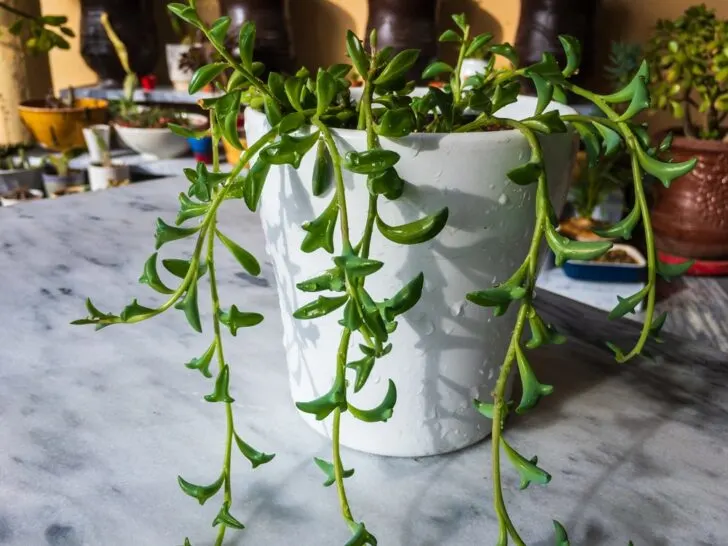
This plant is a hybrid of the String of Pearls plant, but its small leaves look a bit like dolphins. Its tendrils can reach up to six inches (15.24 cm) in length, so it’s ideal for vertical gardens and thrives when kept indoors.
As with other succulents, give it at least six hours of sunlight every day. Other tips for keeping your String of Dolphins healthy include the following:
- Water it when its soil is completely dry. This prevents it from becoming soggy.
- Keep it cool. This type of succulent likes cool temperatures and can withstand temperatures as low as 40 °F (4.4°C).
- Feed it organic fertilizer to enhance growth. You should do this early in the spring to boost its growth. Feed it fish fertilizer. I’d recommend Liquinox Fish Emulsion Fertilizer (available on Amazon.com). It contains nutrients such as zinc and iron, and it’s safe for a variety of plants, such as flowers and shrubs.
Final Thoughts
Hanging succulent plants enhance the appearance of your home and garden. There are beautiful succulents that trail and are worth purchasing, and they share similarities when it comes to looking after them, such as:
- Giving them a few hours of sunlight daily.
- Watering them when their soil feels dry.
- Keeping them in a fast-draining soil mix.
Other Articles You May Also Be Interested In
8 Blue Succulents To Grow in Your Garden

